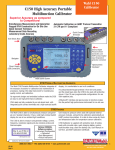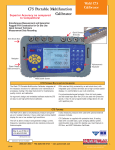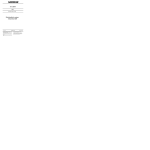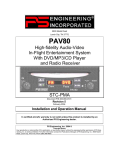Download PS Engineering PMA4000 TSO Installation manual
Transcript
PS Engineering Incorporated PM 1000 FAA TSO Approved Intercom Installation and Operation Manual Section I General Information 1.1 Introduction The PM1000 is an FAA-TSO approved, panel mounted, 2-place intercom system (ICS). Please read this manual completely before installation to minimize the risk of damage to the unit and to become familiar with all the features. 9800 Martel Road 1.2 Lenoir City, TN 37772 Scope This manual contains installation and operational instructions for the following PS Engineering unit: PM1000 2-Place Intercom System Operation and Installation Manual Model PM1000 1.3 Description 2-place intercom system Part Number 11900 Description The PM1000 is a 2-place, panel-mounted intercom with individual volume and squelch controls for the pilot and copilot positions. A front panel mode switch allows the pilot to select one of two possible configurations: FAA-Approved "ISO" mode isolates the pilot from the intercom and connects to the aircraft radio. The copilot can continue listen to entertainment without distracting the pilot. This position will not hear radio communications. TSO C50c Document P/N 200-190-0002 Revision 2 Jan.1998 PS Engineering, Inc. 2001 © Copyright Notice Any reproduction or retransmittal of this publication, or any portion thereof, without the expressed written permission of PS Engineering, Inc. is strictly prohibited. For further information contact the Publications Manager at PS Engineering, Inc., 9800 Martel Road, Lenoir City, TN 37772. Phone (865) 988-9800 "ALL" mode places all headsets on a party line. Each one hears aircraft radio, entertainment and can use the intercom. The PM1000 has an automatic fail-safe interconnect to the aircraft radio. If power to the intercom is disrupted, an internal relay will connect the pilot's headset to the aircraft radio. This allows continuous radio communications. Note: The copilot will no longer hear aircraft radio when power is removed. The LED shows green when power is applied to the unit. An auxiliary input is provided, allowing the pilot and copilot the option to listen to music during flight. During intercom activity, this music is automatically muted to allow communications without distraction. When the activity ceases, the music returns to the original listening volume. Note: the music is NOT muted during radio reception. During times when radio communication is vital, the pilot should select “ISO” mode. Other occasions where radio is of lessor importance, it is possible to put the intercom in the background by reducing the PM1000 volume. The pilot volume control doesn’t effect the volume of the aircraft radio, so it can be adjusted to a more prominent level. Both pilot and copilot have transmit capabilities over the radio. The PM1000 allows only the person who presses their PTT to be heard over the aircraft radio. If both pilot and copilot press the PTT at the same time, 200-190-0002 1 Rev. 2, Jan. 2001 200-190-0002 2 Rev. 2, Jan. 2001 PS Engineering Incorporated PM 1000 FAA TSO Approved Intercom Installation and Operation Manual the copilot will override (Ideally suited for training environments). Pilot regains priority by switching the unit off. 1.4 Approval Basis The PM1000, part number 11900 is FAA-approved under TSO-C50c. 1.5 Specifications Input power: 13.8 - 27.5 Volts DC Current Drain: <110 mA (Externally fused at 1 Amp) Headphone Impedance: 150-1000 Ω typical Audio Distortion: <10% @ 75mW into 150 Ω load Aircraft Radio Impedance: 1000 Ω typical Mic Frequency Response: ±3 dB, 350 Hz — 6000 Hz Unit weight: 10.5 Ounces (0.3 kg) Dimensions: 0.9" H x 2.60" W x 4.85" D (2.3 x 6.6 x 12.3 cm) Environmental and technical qualifications: RTCA DO-160B/DO-170 Temperature -20ºC to +55ºC 1.6 A. B. C. D. E. Equipment required but not supplied Headphone and microphone jacks as needed Headphones, 150Ω monaural, 2 each Microphones, two each Interconnect wiring Circuit Breaker 1 Amp. 1.7 License Requirements None 200-190-0002 3 Rev. 2, Jan. 2001 PS Engineering Incorporated PM 1000 FAA TSO Approved Intercom Installation and Operation Manual 1. Section II Installation 2.1 2. 3. General Information The PM1000 comes with all mounting hardware for installation. A 2-place jack kit is available, part number 250-000-0040. 4. Installation of the PM1000, using the hardware supplied and available wiring, does not require special tools or knowledge other than described in FAA Advisory Circular 43.13-2. It is the installer's responsibility to determine the approval basis for this installation. An FAA Form 337, or other approval may be required. See Appendix B for example of FAA Form 337. 5. PS Engineering Incorporated PM 1000 FAA TSO Approved Intercom Installation and Operation Manual Using the template, drill six holes in the instrument panel in a location convenient to the pilot position(s). Insert the PM1000 from behind the instrument panel, aligning the holes for the knobs, LED, and switch. Depending on the instrument panel thickness (<0.040”), you may elect to use the aluminum faceplate to provide additional support. Place the aluminum plate over the knob shafts and secure, using the two # 440 round head screws provided. Remove the backing from either the horizontal or vertical graphics label provided with the unit, carefully align over the knob shafts, and press firmly in place. Install the knobs over the volume and squelch control shafts. 2.4 Cable harness wiring To complete the installation, a wire harness must be made as shown in Appendix D. 2.2 Unpacking and preliminary inspection The PM1000 was carefully inspected mechanically and thoroughly tested electronically before shipment. It should be free of electrical or cosmetic defect. Upon receipt, verify that the parts kit (p/n 250-001-0001) includes the following: Part Number 475-440-0318 625-001-0002 001-001-0002 430-001-0003 425-025-0002 425-025-0003 475-002-0000 575-001-0001 200-190-0001 122-001-0000 2.3 Description #4-40 Machine screws, black Concentric inner knobs Outer knobs w pointer Aluminum doubler plate 25 pin Sub-d male connector Connector hood Connector Thumbscrews PM1000 label set Operator's and Installation Manual Drill Template Quantity 2 2 2 1 1 1 2 1 1 1 Equipment installation procedures 1.200 0.838 1.200 0.838 0.325 0.265 If the aircraft already has pilot and copilot headset jacks installed, you may re-use them. Remove and discard all wires from the copilot headset jacks. You may use the existing pilot headset jacks as the Auxiliary Aircraft Radio Headset Jacks, but they should be moved to a new location to avoid confusion with the pilot's headphone jacks. In the event the intercom has to be removed for any reason, these jacks provide access to the aircraft radio system. To connect intercom into the aircraft audio system, parallel the appropriate set of cables from the intercom to the Auxiliary Aircraft Radio Headset Jacks. Finally, install new headset jacks into the aircraft and connect them directly to the appropriate pins of the PM1000. See the wiring diagram for all details of the wire harness interconnects. 2.4.1 Electrical Noise Issues WARNING: You must use separate shielded cables for the microphone and headphone jacks. Combining these two wires WILL cause loud oscillations and degrade the intercom function. The oscillation is caused by the cross-coupling between the large headphone signal and the small microphone signal. The resulting feedback is a high-pitched squeal that varies with the volume controls. Due to the variety of the radio equipment found in today's general aviation aircraft, there is the potential of both radiated and conducted noise interference. The PM1000 has a specially designed power supply to reduce conducted electrical noise on the power bus of the aircraft by at least 50dB. Although this is a very large amount of attenuation, it does not eliminate all noise when the amount is excessive. There must be at least 13.75 Volts DC present at the PM1000 for the power supply to work within its designed regulation. Otherwise, it will not be able to attenuate noise properly. 0.250 2 ea. 0.125 PS Engineering can make a custom-tailored wiring harness for the installer. All harnesses use Mil-spec quality components with professional techniques, and are fully tested before shipment. Contact PS Engineering for more information. 2 ea. 0.406 Shielding can protect the system from radiated noise (rotating beacon, electric gyros, switching power supplies, etc.). However, installation combinations can occur where minor interference is possible. The NOT TO SCALE Figure 2-1 Hole Spacing 200-190-0002 5 Rev. 2, Jan. 2001 200-190-0002 6 Rev. 2, Jan. 2001 PS Engineering Incorporated PM 1000 FAA TSO Approved Intercom Installation and Operation Manual PM1000 was designed in an interference -protected chassis and has internal filter capacitors on all input lines. Ground loop noise occurs when there are two different return paths for the same signal, such as airframe and ground return wire. Large cyclic loads such as strobes, inverters, etc., can inject audible signals onto the airframe return path. Follow the wiring diagram very carefully to help insure a minimum of ground loop potential. Radiated signals can be a factor when low level mic signals are bundled with current carrying power wires. Keep these cables separated. Insulating washers are required on all mic and headphone jacks to isolate them from aircraft ground. The use of a conductor instead of a shield for ground return eliminates these ground loop paths. 2.4.2 PS Engineering Incorporated PM 1000 FAA TSO Approved Intercom Installation and Operation Manual The PTT is built into the pilot and copilot yokes Simply install the plugs from the headset into the aircraft headphone jacks. Then use the yoke mounted PTT to transmit. No other action is required. CASE II Built in PTT only on the pilot side This configuration requires a modified external PTT switch plugged into the copilot's mic jack. (See Appendix A) When the copilot's PTT is depressed, this activates an internal relay that switches the mic audio to the aircraft radio from the pilot to the copilot. Case III Power Requirements No built in PTT switch at all. The PM1000 was designed to work with 12.8 to 27.5 volt DC negative ground systems. The PM1000 must be externally protected with a one ampere (1A) circuit breaker or fuse. 2.4.3 Auxiliary Input 2.5 An entertainment device can be connected to the PM1000. Install a " stereo jack convenient the pilot to connect the entertainment device into the system. A muting system is incorporated in the PM1000 that will mute the music during intercom activity only. Note: The radio will not mute the music. WARNING: Local oscillators and other internal signals from CD or radio equipment can cause undesired interference with VHF navigation and communication equipment. Before takeoff, operate the entertainment device to determine if there is any adverse effect on aircraft systems. If any unusual operation is noted in flight, immediately switch the entertainment device off. 2.4.4 Optional accessories The PM1000 can be interfaced to optional expansion units (11918, 11918R) to add additional capabilities, such as a crew mode. The interconnect is shown in Appendix D. Because these modules are not TSOapproved, we recommend that the FAA-approved PM1000II, part number 11920, with crew, be used instead of the PM1000, in new installations, if these functions are desired. 2.4.5 Two built-in PTT must be installed or two external, modified PTT switches will be required for both the pilot and copilot. Modifications to the PTT may be required. (See Appendix A) External PTT hook-up Part of the installation includes the installation of PTT (Push To Talk) switches that allow radio transmissions from pilot and copilot positions. Post installation checkout After wiring is complete, verify power is ONLY on pin 14 of the connector, and airframe ground on pin 1. Failure to do so will cause serious internal damage and void PS Engineering's warranty. 1. Apply power to the aircraft and avionics. 2. Plug headsets into the pilot, copilot and passenger positions. 3. Verify that the pilot position can transmit and receive with the PM1000 in the OFF position (left hand volume knob fully counterclockwise). 4. Rotate the pilot volume clockwise, about half way. Verify that the green Power light comes on. 5. Verify that the pilot can transmit and receive on the com transceivers. 6. Verify proper intercom operation for pilot and copilot. For more information, consult Section III. 7. Verify proper transmit and receive operation on the copilot position, noting that the copilot PTT switch allows proper transmission on the selected transceiver. 8. Verify proper Intercom system operation in the ALL and ISO modes. 9. Verify that the intercom system does not adversely affect any other aircraft system by systematically switching the unit on and off, while monitoring the other avionics and electrical equipment on the aircraft. There are three configurations that can be used. You must select the case that best fits your installation. NOTE: Only the person who presses their PTT switch will be heard over the radio. CASE I 200-190-0002 7 Rev. 2, Jan. 2001 200-190-0002 8 Rev. 2, Jan. 2001 PS Engineering Incorporated PM 1000 FAA TSO Approved Intercom Installation and Operation Manual PS Engineering Incorporated PM 1000 FAA TSO Approved Intercom Installation and Operation Manual a power failure to the PM1000, or if the power switch is turned off, the copilot will not hear the aircraft radio. Only the pilot is connected directly to the aircraft radio. Section III OPERATION With the installation is complete, turn the PM1000 on by rotating pilot's volume control. This also engages the automatic fail-safe system. The pilot's volume control does not control the volume of the aircraft radio, allowing an additional degree of aircraft radio listening flexibility. ISO (Up Position): The pilot is isolated from the intercom and is connected only to the aircraft radios. He will hear the aircraft radio reception (and sidetone during radio transmissions). The copilot will hear music but not the aircraft radio traffic. ALL (Middle position): All parties will hear the aircraft radio, intercom, and music. However, during any ICS conversation, the music volume automatically mutes. The music volume increases gradually back to the original level after communications have been completed. The switch has a down position which is the same as ALL. 3.4 Optional accessories The PM1000 can be interfaced to optional expansion units (11918, 11918R, 11616) or expansion modules (Telcom IV portable) to add additional capabilities, such as a crew mode. In CREW mode, pilot and copilot are connected on one intercom channel while the passengers are on a separate and independent channel. The pilot and copilot are connected to the aircraft radio and may listen to Music. Passengers can continue to communicate with themselves without disturbing the pilot and copilot, and will hear the main music input. Figure 0-1 PM1000 front panel controls 3.1 Because the optional expansion modules are not FAA-TSO approved, we recommend the more capable FAATSO approved PM1000II be installed instead of the PM1000 unit if these features are desired. Adjusting the Volume The pilot's volume control knob adjusts the loudness of the intercom and music for the pilot's headset only. It has no effect on aircraft radio volume level. The copilot's volume control adjusts the intercom, music and radio volume for the copilot. 3.2 Adjusting the Squelch Control The PM1000 provides individual VOX circuits for the pilot and copilot. The ability to adjust the trip level of these VOX circuits (squelch control) allows the use of dissimilar headsets without the frustration of clipping the first syllables. The PM1000 has two squelch circuits, one for the pilot, another for the copilot. With dual VOX circuits, background noise is dramatically reduced. With the engine running, set the squelch control knob by slowly rotating the knob clockwise until the background noise in the earphones stops. When the microphone is positioned properly near the lips, normal speech levels should open the channel. When you have stopped talking, there is a delay of about one-second before the channel closes. This prevents squelch closure between words, and helps eliminate choppy intercom conversations. 3.3 Mode Select The center switch is a two-position mode control that allows the pilot to tailor the intercom function to suit flight conditions. Regardless of configuration, the pilot will always hear the aircraft radio. NOTE: If there is 200-190-0002 9 Rev. 2, Jan. 2001 Section 4 Warranty and service 4.1 Warranty In order for the factory warranty to be valid, the installations in a certified aircraft must be accomplished by an FAA- certified avionics shop and authorized PS Engineering dealer. If the unit is being installed by a noncertified individual in an experimental aircraft, a factory-made harness must be used for the warranty to be valid. PS Engineering, Inc. warrants this product to be free from defect in material and workmanship for a period of one year from the date of installation. During this one year warranty period, PS Engineering, Inc., at its option, will send a replacement unit at our expense if the unit should be determined to be defective after consultation with a factory technician. The buyer is responsible for shipping charges to return the exchanged unit. This warranty is not transferable. Any implied warranties expire at the expiration date of this warranty. PS Engineering SHALL NOT BE LIABLE FOR INCIDENTAL OR CONSEQUENTIAL DAMAGES. This warranty does not cover a defect that has resulted from improper or unreasonable use or maintenance as determined by us. This warranty is void if there is any attempt to dissemble this product without factory authorization. This warranty gives you specific legal rights, and you may also have other rights which may vary from state to state. Some states do not allow the exclusion of limitation of incidental or consequential damages, so the above limitation or exclusions may not apply to you. 200-190-0002 10 Rev. 2, Jan. 2001 PS Engineering Incorporated PM 1000 FAA TSO Approved Intercom Installation and Operation Manual 4.2 PS Engineering Incorporated PM 1000 FAA TSO Approved Intercom Installation and Operation Manual Factory Service Appendix A — PTT Modifications The PM1000 is covered by a one-year limited warranty. See warranty information. Call PS Engineering, Inc. at (865) 988-9800 before you return the unit. This will allow the service technician to provide any other suggestions for identifying the problem and recommend possible solutions. After discussing the problem with the technician and you obtain a Return Authorization Number, ship product to: When received from the manufacturer, an after-market PTT switch opens the mic audio path to the "ring" connection of the PTT mic plug. When the PTT is between the intercom and the headset, the intercom function will not work until the PTT switch is depressed. A simple modification can be performed to allow proper intercom operation. NOTE: This mod does not alter normal operation. The following are sample procedures for common PTT switches. Contact the PTT manufacturer if you require more information. Procedures for the David Clark PTT 1. Unscrew the round black plastic cover from the jack. 2. Connect the joined black wires to the red wire 3. Replace the plastic cover. PS Engineering, Inc. Service Department 9800 Martel Road Lenoir City, TN 37772 (865) 988-9800 FAX (865) 988-6619 Procedures for the Telex PT-200 1. Unscrew the round black plastic cover from the jack. 2. Cut the red wire in the middle of the wire. 3. Strip both ends of the insulation. 4. Solder the two ends to the ground lug to the PTT jack 5. Replace the plastic cover. Procedures for the Telex PT-300 1. Unscrew the round black plastic cover from the jack. 2. Remove the heat shrink material from the joined black wires. 3. Solder these two wires to the lug that has a white wire already soldered to it. 4. Replace the plastic cover. 6. Appendix B Instructions for FAA Form 337 One method of airworthiness approval is through an FAA Form 337, Major Repair and Alteration (Airframe, Powerplant, Propeller, or Appliance) In the case of the PMA1000II 11920, you may use the following text as a guide. Installed 2-place intercom, PS Engineering PM1000, part number 11900 in ( location ) at station . Installed per AC43.13-2, Chapter 2, paragraph 23 (Instrument Panel Mounting). Installed per PS Engineering Installation Operators Manual p/n 200-190-0001, revision 1, dated Nov. 1998. This unit is FAA-Approved under TSO C50c for audio amplifiers, and meets environmental tests outlined in RTCA DO170B as appropriate or this aircraft. Interface to existing aircraft radios in accordance with installation manual and in compliance with practices listed in AC43.13-2, Chapter 2. All wires are Mil-Spec 22759 or 27500. No connection to the aircraft dimmer bus is required. Power is supplied to the unit through a 1A circuit breaker (type and part number), and total electrical load does not exceed % of the electrical system capacity with the PMA1000 added. Aircraft equipment list, weight and balance amended. Compass compensation checked. A copy of the operation instructions, contained in PS Engineering document 200-190-0001, Revision 1, November 1998, is placed in the aircraft records. All work accomplished listed on Work Order . 200-190-0002 11 Rev. 2, Jan. 2001 200-190-0002 12 Rev. 2, Jan. 2001 PS Engineering Incorporated PM 1000 FAA TSO Approved Intercom Installation and Operation Manual 7. PS Engineering Incorporated PM 1000 FAA TSO Approved Intercom Installation and Operation Manual Appendix C, Instructions for continuing airworthiness The PM1000 is considered an “on-condition” maintenance item. It is checked prior to each flight during normal operation. There are no additional considerations for continuing airworthiness other than the practices detailed in AC 43.13-1A, Chapter 15, Paragraph 750. This includes inspecting the unit to be sure it is securely fastened in its location, and that the wiring harness is not chafed or pinched, and remains secure. All panel jacks should be checked at each periodic inspection to ensure that they are tight and not in contact with other items behind the instrument panel. 8. Appendix D Wiring Diagrams Headset Plug Ring (audio) AUX Headphone Jack To Aircraft Radio Phone Low Aircraft Radio PTT 12 Aircraft Radio PTT Aircraft Mic Audio Hi 25 Aircraft Mic Audio Lo 13 Aux Mic Jack To Aircraft Radio Mic Audio Lo Barrel (audio gnd) Barrel (gnd) (audio) Copilot Mic PTT Copilot Mic Audio Hi Mic Audio Lo Pilot Mic PTT Pilot Mic Audio Hi Pilot Mic Audio Lo 1 2 3 4 5 6 7 8 9 10 11 12 13 Music Input Hi Music Input Lo 14 15 16 17 18 19 20 21 22 23 24 25 Ground Power (11-33 VDC) Pass Phones Lo Pass Phones Hi Music #2 Lo Music 2 Hi A/C Radio Ground A/C Radio Input Pilot Phones Gnd Pilot Phones Hi Copilot Phones Lo Copilot Phones Hi Music 1 Input Lo Music 1 Input Hi No Connection Copilot Mic Hi No Connection Copilot PTT Copilot & Pass Mic Lo Pilot Mic Audio Hi Pilot Mic Lo Pilot PTT A/C Radio PTT A/C Mic Audio Hi A/C Radio Gnd Pilot Headphone Jack Copilot Mic Jack 22 21 10 Copilot PTT Pilot Mic Jack 24 23 11 Pilot PTT 20 7 Power Out (+9VDC) 15 Expansion Audio In 3 Expansion Audio Out 16 Ground 2 Music Jack To Pin 3 of 11918 expansion module To Pin 1 of 11918 To Pin 4 of 11918 To Pin 2 of 11918 These pins used for expansion modules only NOTES: 1. All wire must conform to MIL-22759 or 27500. Minumum 24 gage shielded wire. 2. Use 2-, 3-, and 4-conductor with shield as indicated. 3. Use insulating washers on all jacks. 4. Connect shields at intercom end only 5. AUX headphone and microphone jacks are required. Figure 2 Connector Diagram (Unit has Male Pins) 13 Copilot Headphone Jack 8 9 Pilot Phone Audio Hi 18 Pilot Phone Audio Lo 5 Viewed from Front of Unit 200-190-0002 To Aircraft Radio Phone Hi A/C Radio Phone Audio Hi 17 A/C Radio Phone Audio Lo 4 No Connection No Connection TIP (PTT) headphone TIP (phone audio hi) 11-33 VDC Copilot Phones Audio Hi 19 Copilot Phones Audio Lo 6 Ring (audio) Barrel (gnd) TIP (PTT) 1A To A/C Radio Mic Audio Hi Jack Details: Microphone 11900 Sub-D DB-25 Male (on unit) 14 1 Power In Ground Rev. 2, Jan. 2001 200-190-0002 14 9800 MARTEL ROAD, LENOIR CITY TN 37922 TITLE: PM1000 (11900) 2-PLACE WIRING DIAGRAM SIZE DOCUMENT NUMBER: REV 120-121-0001 DATE: 11/06/98 SHEET 1 OF 2 1 ECO Rev. 2, Jan. 2001
















